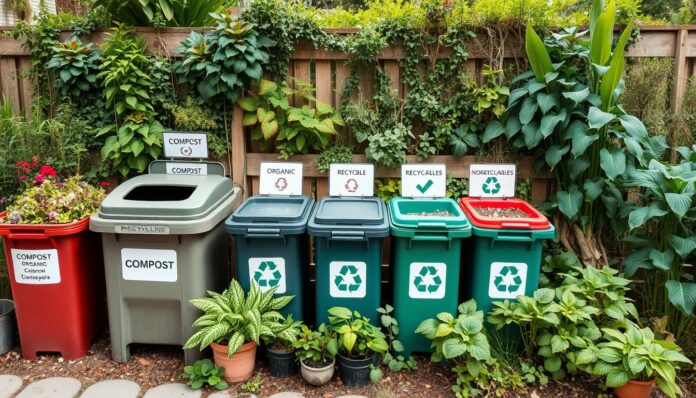What if the key to a more sustainable future lies in how we manage waste? Permaculture waste sorting is key to living sustainably. By sorting waste well, we can lessen our impact on the environment and make our gardens greener. This method of managing waste is crucial for our planet.
Permaculture teaches us to sort different types of waste, like food scraps and yard trimmings. By composting and harvesting rainwater, we can cut down on waste. Recycling organic waste turns it into valuable soil amendments.
Key Takeaways
- Permaculture waste sorting is essential for sustainable living and reducing environmental footprint.
- Sustainable waste management and organic waste recycling are crucial aspects of permaculture.
- Composting and rainwater harvesting can significantly reduce waste output and create a more closed-loop ecosystem.
- Implementing efficient waste sorting practices can help individuals reduce their waste output and create a more eco-friendly garden or homestead.
- Permaculture waste sorting can have a significant impact on the environment and contribute to environmental sustainability and economic benefits.
- Understanding the different types of waste generated in urban permaculture is crucial for effective waste management.
Understanding Permaculture and Waste Prevention
Permaculture is a way to design sustainable ecosystems. It focuses on reducing waste and using resources wisely. By sorting waste and adopting eco-friendly practices, we can make a big difference.
Defining Permaculture Principles
Permaculture is built on three main principles: earth care, people care, and fair share. These principles help create systems that are good for the environment, society, and economy. They guide us in reducing waste and using resources efficiently.
The Importance of Waste Reduction
Reducing waste is key in permaculture. It saves natural resources, cuts down pollution, and supports sustainable living. By using waste reduction strategies, we can lower our waste, save money, and help the planet.
For instance, composting food waste can cut down landfill waste and make great soil for gardens. Recycling and reusing materials also save resources and reduce waste.
| Waste Reduction Strategy | Benefits |
|---|---|
| Composting | Reduces waste sent to landfills, creates nutrient-rich soil |
| Recycling | Conserves natural resources, reduces waste generated |
| Reusing materials | Reduces waste generated, saves money |
By using these strategies, we can help make our environment more sustainable. We promote eco-friendly waste practices and contribute to a better future.
The Role of Waste in Permaculture Systems
Permaculture systems aim to create a closed-loop environment. They minimize waste and use resources efficiently. By using green waste solutions and sustainable living practices, we can reduce our environmental impact. Effective waste segregation methods are key to achieving this goal.
Managing waste in permaculture systems involves composting, vermicomposting, and mulching. These methods turn organic waste into nutrient-rich soil amendments. This reduces the need for synthetic fertilizers. By adopting these practices, we can create a more self-sufficient and regenerative environment.
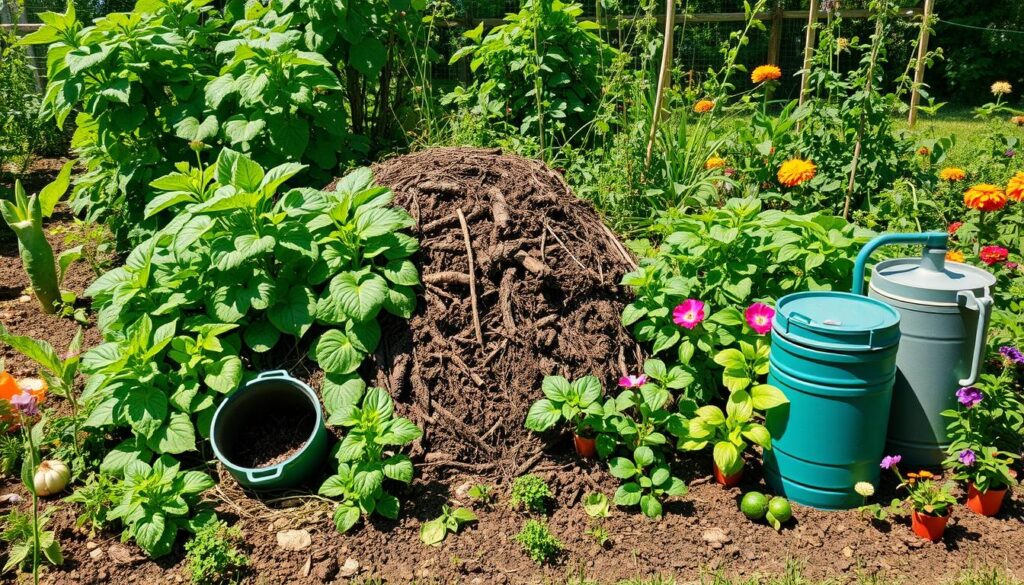
Permaculture systems also use waste segregation methods to optimize resource use. This includes separating organic materials from inorganic waste. Techniques like hugelkultur create nutrient-rich planting areas. By using these approaches, we can reduce waste and create a more sustainable environment.
| Waste Management Technique | Description | Benefits |
|---|---|---|
| Composting | Converting organic waste into nutrient-rich soil amendments | Reduces need for synthetic fertilizers, creates nutrient-rich soil |
| Vermicomposting | Using worms to break down organic waste | Produces nutrient-rich vermicast, reduces waste volume |
| Mulching | Applying organic materials to soil surface to retain moisture and suppress weeds | Retains soil moisture, reduces weed growth, improves soil health |
By using these waste management techniques and sustainable living practices, we can create a more regenerative and self-sufficient environment. This approach not only reduces waste but also promotes biodiversity and improves ecosystem health.
Composting: Turning Waste into Nutrient-Rich Soil
Composting is key in permaculture. It turns organic waste into rich soil. This is vital for sustainable waste management and can be done in many ways. By recycling organic waste, we can make our gardens and homes greener.
Composting has many benefits. It can cut down greenhouse gas emissions by 30-40%. It also makes a natural fertilizer that makes soil better. For instance, worm castings have more nutrients than regular compost. Using grass clippings as mulch can boost soil nitrogen by 10%.
Sorting waste properly is crucial for composting. It makes sure we’re composting the right stuff.
Types of Composting Techniques
- Vermicomposting: using worms to break down organic matter
- Hot composting: creating a compost pile that generates heat to speed up the decomposition process
- Cold composting: allowing organic matter to break down naturally over time
Benefits of Composting in Permaculture
Composting cuts down methane emissions, a strong greenhouse gas. It makes soil need less water and synthetic fertilizers. This reduces harm to the environment in farming.
By adding composting to permaculture, we can make our surroundings more sustainable and green.
| Composting Benefits | Environmental Impact |
|---|---|
| Reduces greenhouse gas emissions | 30-40% reduction |
| Creates natural fertilizer | Enhances soil fertility |
| Conserves water | Reduces water usage |
Water Management for Waste Prevention
Effective water management is key in permaculture. It helps cut down waste and supports eco-friendly practices. By using smart water systems and harvesting rainwater, we can waste less water. This makes our living spaces more sustainable.
These methods are linked to reducing waste in permaculture. They help us use resources better and reduce what we throw away.
Some important water management strategies in permaculture include:
- Creating efficient water systems that minimize waste and promote reuse
- Implementing rainwater harvesting techniques to collect and store rainwater for non-potable uses
- Using waste sorting techniques to separate and recycle organic waste, reducing the amount of waste sent to landfills
By using these strategies, we can lessen our environmental impact. Practices like composting and recycling also help reduce waste. This shows how crucial water management is in permaculture for reducing waste and promoting sustainability.
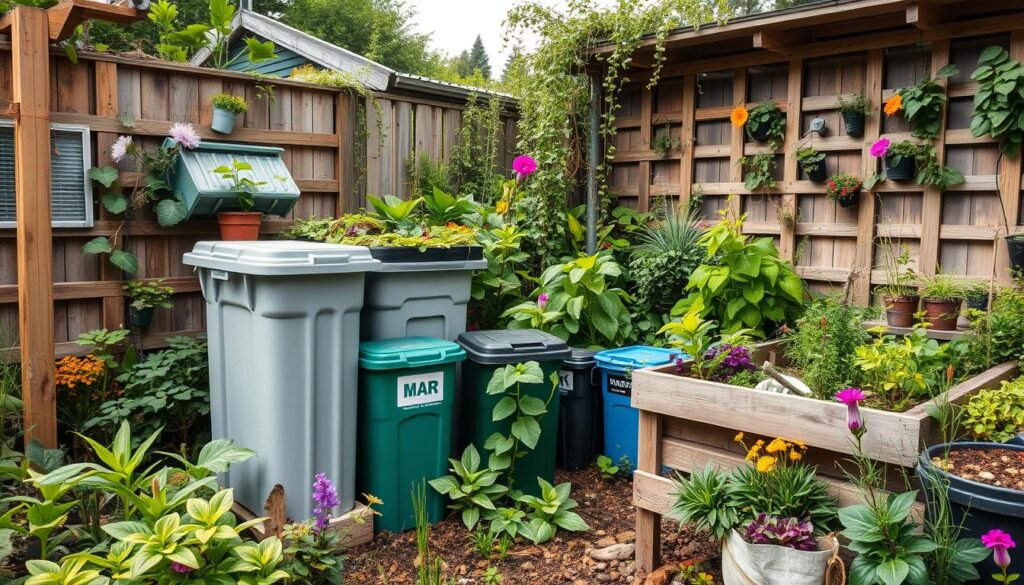
By adopting these strategies, we can make our living spaces more sustainable. Eco-friendly practices like composting and recycling also play a big role. As we keep exploring water management in permaculture, it’s clear it’s vital for reducing waste and promoting sustainability.
| Strategy | Description |
|---|---|
| Efficient water systems | Minimize waste and promote reuse |
| Rainwater harvesting | Collect and store rainwater for non-potable uses |
| Waste sorting techniques | Separate and recycle organic waste |
Plant Selection for Reducing Waste
Plant selection is key in permaculture for reducing waste. Choosing the right plants makes gardens or homesteads more diverse and resilient. Green waste solutions include using native plants, which need less care. Companion planting also helps, reducing the need for pesticides and thus waste.
Native plants thrive in local conditions, needing less water and fertilizers. This helps in waste segregation methods by cutting down on packaging and transport waste. Adopting these strategies leads to a more sustainable garden or homestead.
Native Plants and Their Benefits
Native plants fit local climates and soils well, making them perfect for permaculture. They need less care, cutting down on fertilizers and pesticides. This supports sustainable living practices by reducing packaging and transport waste.
Companion Planting for Pest Control
Companion planting helps control pests and diseases in permaculture. By planting certain species together, we can avoid pesticides and fertilizers. This method is a form of waste segregation, using natural practices to reduce waste.
Incorporating Animal Systems
Animal systems are key in permaculture, helping with permaculture waste sorting and sustainable waste management. By adding animals to permaculture designs, we can make a system that uses resources better and wastes less.
Benefits of Using Livestock
Livestock is useful for many things, like meat, dairy, wool, and organic waste recycling. Each animal brings its own benefits, such as:
- Cattle: help keep biodiversity and keep soil carbon levels up
- Goats: quickly clear areas of brambles and poisonous oak
- Rabbits: give manure, meat, and help control weeds, showing they’re very useful in permaculture
Waste Management through Animal Integration
Using animals is key for sustainable waste management in permaculture. Animals help reduce landfill waste and make our economy more circular. For instance, permaculture waste sorting helps separate organic waste. This waste can then be composted and used as fertilizer.
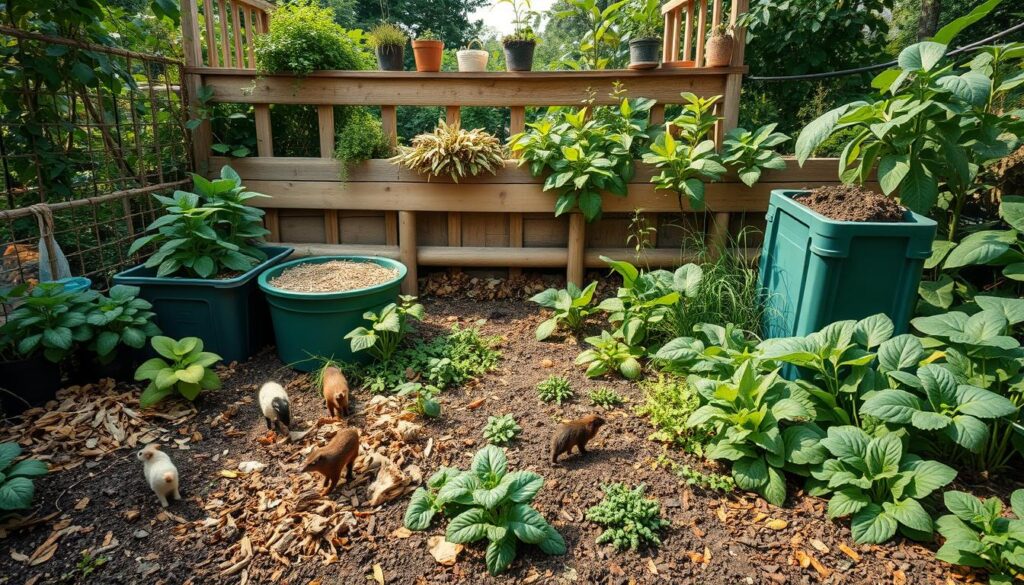
| Animal | Benefit |
|---|---|
| Cattle | Maintain biodiversity and ensure soil carbon storage |
| Goats | Clear acres of brambles and poisonous oak |
| Rabbits | Provide manure, meat, and weed control |
The Importance of Crop Rotation
Crop rotation is key in permaculture systems. It keeps the soil healthy and cuts down on waste. By using eco-friendly waste practices and sorting techniques, we can make our gardens or homesteads more sustainable. This not only helps the environment but also reduces waste in permaculture.
Good crop rotation means planning and mixing up crops. This way, we avoid depleting the soil and get better yields. Some ways to do this include:
Methods of Crop Rotation
- Rotating between legumes and cereals to improve soil fertility
- Alternating between root vegetables and leafy greens to reduce pest and disease buildup
- Incorporating cover crops to enhance soil health and reduce erosion
How Rotation Reduces Soil Depletion
Crop rotation makes the soil better and stops erosion. It does this by changing the root systems, making the soil more stable. Legumes in the rotation can also cut down on the need for synthetic fertilizers. This helps reduce waste and supports eco-friendly gardening.
Utilizing Greywater in Permaculture
Greywater is key in permaculture, helping us use green waste solutions and sustainable living practices. It lets us cut down on water use, with non-toilet water making up about 2/3 of our total use. This method also helps us manage organic waste better.
Every person produces about 30-50 gallons of greywater daily, with the kitchen being the biggest source. It’s important to check greywater and grease traps monthly. Also, greywater is alkaline, so we need to be careful when using it on plants. It’s best to dilute it before using it in the soil.
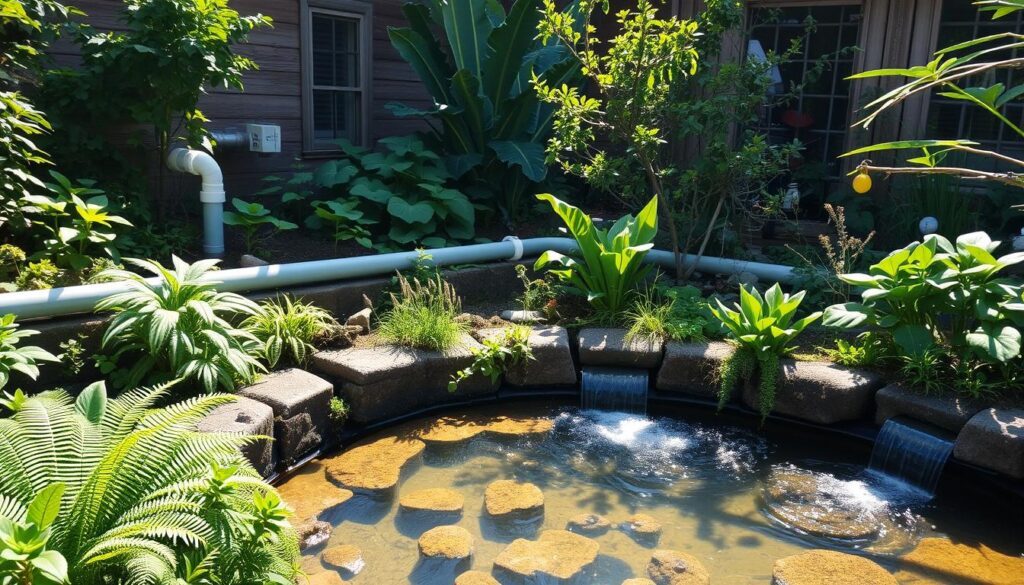
- Avoiding the use of boron-based detergents and those that soften water in washing applications
- Cleaning greywater systems every 5 years on average to prevent clogging from biological material
- Implementing a settling tank that requires cleaning at least once a year to prevent sediment build-up
By following these steps, we can make our systems more efficient. This reduces our environmental footprint and supports sustainable living practices.
Building Soil Health for Waste Reduction
Soil health is key in permaculture systems. It’s vital for reducing waste. By using organic waste recycling, we can make our gardens or homes more sustainable. This is done through permaculture waste sorting and sustainable waste management strategies.
Improving soil health brings many benefits. It increases soil organic carbon and improves water retention. It also makes nutrient cycling more efficient. For instance, composting can cut down household organic waste by 50%. Cover cropping can boost soil nitrogen by 30% on average.
Here are some ways to improve soil health for waste reduction:
- Implement composting and vermicomposting techniques to reduce organic waste
- Use cover crops to enhance soil health and reduce erosion
- Incorporate organic matter into the soil to improve soil structure and fertility
By using these strategies, we can make our gardens or homes more sustainable. This reduces waste and improves soil health. This approach to sustainable waste management helps the environment. It’s done through organic waste recycling and permaculture waste sorting practices.
| Soil Health Benefits | Percentage Increase |
|---|---|
| Soil Organic Carbon | 20-30% |
| Soil Water Retention | 40% |
| Nutrient Cycling Efficiency | 30% |
Energy Efficiency in Permaculture Design
Energy efficiency is key in permaculture design. It helps people reduce their environmental impact and use energy wisely. By sorting waste and composting, we can live more sustainably.
Using renewable energy like solar and wind power is important. Also, systems like greywater and rainwater harvesting save energy. Building with natural materials and using passive solar design are other ways to be efficient.
Renewable Energy Options
Renewable energy sources like solar and wind power are vital. They help power homes and systems in permaculture. Using these options reduces our need for non-renewable energy and cuts down on pollution.
Strategies for Reducing Energy Waste
To cut down on energy waste, we can use efficient systems and materials. Greywater and rainwater harvesting are good examples. Also, choosing energy-saving appliances and lights helps a lot.
- Use solar power for electricity and heating water
- Install greywater systems to save water
- Collect rainwater for irrigation and other uses
- Build with natural materials and use passive solar design
- Choose energy-saving appliances and lights
By using these strategies, we can live more sustainably and reduce our environmental impact.
Design Techniques to Minimize Waste
Effective design techniques are key in reducing waste in permaculture systems. By using green waste solutions and sustainable living practices, we can create a more closed-loop system. This means separating organic and inorganic waste for efficient composting and recycling.
Permaculture design includes zone planning for better efficiency. Different areas are set for specific activities like food production, animal care, and waste management. This method cuts down waste and boosts productivity. For instance, composting toilets and recycling greywater save a lot of water.
By applying these design techniques, we can develop strategies to cut down waste and boost efficiency. This is good for the environment and supports sustainable living. It also lessens our need for outside resources.
| Design Technique | Benefits |
|---|---|
| Zone Planning | Reduces waste, increases productivity |
| Composting Toilets | Reduces water waste, produces fertilizer |
| Greywater Recycling | Conserves water, reduces waste |
Community Involvement in Waste Prevention
Getting the community involved in waste prevention is key. Permaculture waste sorting is a big part of this effort. By using sustainable waste management, we can make our communities greener. The USDA supports urban agriculture and new production methods, offering funding for community projects.
The Office of Urban Agriculture and Innovative Production (OUAIP) has funded projects on composting and reducing food waste. For example, the Prescott Community Compost Program aims to make 28 tons of compost in two years. Also, urban farms in Queens and Brooklyn have kept 600,000 pounds of waste out of landfills, making 350 cubic yards of compost for farmers.
To join in on waste prevention efforts, you can:
- Help out in local community gardens
- Support urban agriculture projects
- Use sustainable waste management in your daily life
Together, we can greatly reduce waste and work towards a sustainable future. It’s vital to include permaculture waste sorting and organic waste recycling in our community projects. This helps create a greener environment for everyone.
| Project | Location | Duration | Goal |
|---|---|---|---|
| Prescott Community Compost Program | Prescott | 2 years | Create 28 tons of compost |
| Urban Farms in Queens and Brooklyn | Queens and Brooklyn | Ongoing | Divert food scraps and green waste from landfills |
Innovative Technologies in Permaculture
Using eco-friendly waste practices is key for living sustainably. New technologies help a lot in this area. They let people track their waste and sort it better. This helps reduce waste and leads to a greener life.
Experts say that using new tech in permaculture makes things better. For example, online tools help share tips on reducing waste. This lets more people learn and act on these ideas.
- Starting composting to cut down on food waste
- Choosing reusable items to avoid single-use plastics
- Using waste sorting techniques for right waste disposal
By adding these habits to our daily lives, we help make the future greener. This follows the goals of permaculture waste reduction.
Education and Awareness on Waste Prevention
Learning about green waste solutions and sustainable living is key. Understanding waste segregation helps us make better choices. This way, we all help our community become greener.
The Environmental-Ambassador Education Program teaches people about environmental sustainability. San Francisco’s Zero Waste program shows how effective waste management can be, with an 80% landfill diversion rate.
Workshops and Training in Permaculture
Workshops and training are essential for learning about permaculture and waste prevention. They offer hands-on experience and knowledge. This helps people apply sustainable practices in their daily lives.
Resources for Continued Learning
There are many resources for those interested in waste prevention and sustainable living. Online courses, workshops, and community programs cover various topics. They help individuals stay informed and make a difference.
By adopting sustainable practices, we contribute to a closed-loop system. This benefits the environment and promotes a healthier community. Education and awareness, as seen in the Sawangan Pilot Waste Management Program, lead to less waste and better health.
Measuring Waste in Permaculture Systems
Measuring waste is key in permaculture systems. It helps find ways to improve and make sustainable waste management better. By using organic waste recycling and permaculture waste sorting, we can lessen our impact on the environment. This makes our gardens or homes more eco-friendly.
Key Metrics for Waste Assessment
To measure waste well, we need to track important metrics. These include the amount of waste, the types of waste, and how we dispose of it. This information helps us spot where we can do better and find ways to cut down on waste.
Tools for Waste Audits
Doing regular waste audits is crucial to understand waste patterns and find ways to reduce it. Some tools for waste audits are:
- Waste sorting and categorization
- Weight and volume measurements
- Waste tracking and monitoring systems
By using these tools and practicing organic waste recycling and permaculture waste sorting, we can make our permaculture systems more sustainable and eco-friendly.
| Waste Reduction Strategy | Benefits |
|---|---|
| Composting | Reduces waste, creates nutrient-rich soil |
| Recycling | Conserves resources, reduces landfill waste |
| Waste Sorting | Identifies areas for improvement, optimizes waste management |
Case Studies: Successful Waste Prevention
Many countries and cities have started using eco-friendly waste practices. For example, Sweden imports waste to keep its recycling plants running. Kamikatsu, Japan, has a system where residents sort waste into 45 categories, leading to high recycling rates.
Taiwan’s “4-in-1 Recycling Program” and San Francisco’s composting law are also successes. Toronto’s Green Bin Program turns millions of tons of organic waste into compost. This makes the city greener.
Some examples of permaculture waste reduction success include:
- Capannori, Italy, aimed for zero waste by 2020 and has cut landfill waste since 2007
- Vashon Island, Washington, has community programs for reuse and repair, reducing waste
- Soneva aims to be zero waste to landfill by 2025 and has cut food waste by 50% since 2019
These efforts show how important community involvement, new policies, and detailed plans are. They help reach sustainability goals through eco-friendly waste practices and sorting techniques.
| Location | Initiative | Outcome |
|---|---|---|
| Sweden | Importing waste for recycling | High recycling rates |
| Kamikatsu, Japan | 45-category waste sorting | High recycling rates |
| Taiwan | “4-in-1 Recycling Program” | Increased recycling rates |
Conclusion: The Future of Waste Prevention in Permaculture
The principles of permaculture change how we handle waste and manage land. By using composting, water harvesting, and diverse planting, we can make ecosystems that need little outside help. These systems also boost biodiversity and keep ecosystems healthy.
Looking ahead, using permaculture could solve big global problems like waste, food security, and climate change. It teaches us how to sort waste and manage it sustainably. This way, we can all help make a better future for recycling and waste management.

